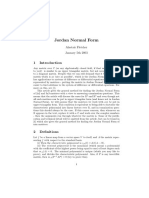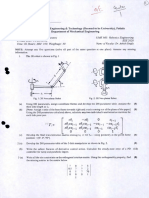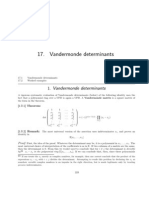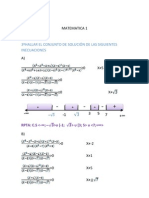Linear Algebra and Matrix Theory: Part 4 - Eigenvalues and Eigenvectors
Linear Algebra and Matrix Theory: Part 4 - Eigenvalues and Eigenvectors
Uploaded by
crazynupCopyright:
Available Formats
Linear Algebra and Matrix Theory: Part 4 - Eigenvalues and Eigenvectors
Linear Algebra and Matrix Theory: Part 4 - Eigenvalues and Eigenvectors
Uploaded by
crazynupOriginal Description:
Original Title
Copyright
Available Formats
Share this document
Did you find this document useful?
Is this content inappropriate?
Copyright:
Available Formats
Linear Algebra and Matrix Theory: Part 4 - Eigenvalues and Eigenvectors
Linear Algebra and Matrix Theory: Part 4 - Eigenvalues and Eigenvectors
Uploaded by
crazynupCopyright:
Available Formats
Linear Algebra and Matrix Theory
Part 4 - Eigenvalues and Eigenvectors
1. References (1) S. Friedberg, A. Insel and L. Spence, Linear Algebra, Prentice-Hall. (2) M. Golubitsky and M. Dellnitz, Linear Algebra and Dierential Equations Using Matlab, Brooks-Cole. (3) K. Homan and R. Kunze, Linear Algebra, Prentice-Hall. (4) P. Lancaster and M. Tismenetsky, The Theory of Matrices, Academic Press. (5) G. Strang, Linear Algebra and Its Applications, Academic Press.
2. Solved Problems 1. Find the eigenvalues and the corresponding eigenspaces of the matrix
1 1 0 A = 1 2 1 0 1 1
Solution: A scalar is an eigenvalue if and only if the kernel of I A is a nontrivial subspace of F31 . That subspace is the corresponding eigenspace. Recall that row equivalent matrices have the same null space. Use symbolic row-reduction on the matrix I A to obtain a row equivalent matrix whose
1
kernel is easy to nd. Several steps may be combined. 1 0 2 1 1 1 I A = 1 2 1 0 1 1 0 1 1 1 1 0
2 1 1 1 1 2 0 1 1 0 1 1 0 2 + 3 1 ( 1) 0 0 ( 1)( 3) The last matrix has a nontrivial null space if and only if its determinant is zero. Obviously, that occurs for = 0, 1, 3. These are the eigenvalues. Let us rst nd the eigenspace for = 0. From above, substituting = 0, we need the solutions of 1 2 1 | 0 0 1 1 | 0 . 0 0 0 | 0 All solutions are of the form x1 = x2 = x3 , so the rst eigenspace is S (0) = sp{(1, 1, 1)t }.
For = 1 the eigenspace S (1) is the set of all solutions of 1 1 1 | 0 0 1 0 | 0 . 0 0 0 | 0
Now the solutions are of the form x2 = 0, x3 = x1 . Thus, S (1) = sp{(1, 0, 1)t }
The eigenspace for = 3 is S (3) = sp{(1, 2, 1)t }
The details are left to you. 2. Tell why it is possible to diagonalize the matrix A of problem 1. Then nd a similarity transformation that diagonalizes it. Solution: The answer to the question depends on two theorems. One theorem asserts that eigenvectors corresponding to distinct eigenvalues are linearly independent. Since we have three distinct eigenvalues: 0, 1, and 3, any three vectors (other than the zero vector) belonging to their respective eigenspaces are linearly independent. In particular, v1 = (1, 1, 1)t , v2 = (1, 0, 1)t , and v3 = (1, 2, 1)t are linearly independent. Therefore, they form a basis for R31 . The second theorem alluded to above asserts that a matrix (or linear transformation on a nite dimensional vector space) is diagonalizable if and only if there is a basis for the space consisting of eigenvectors of the matrix or transformation. Clearly, {v1 , v2 , v3 } above is a basis for R31 , so A is diagonalizable. This means that A is similar to a diagonal matrix, or that there is a nonsingular matrix Q such that Q1 AQ = , a diagonal matrix. The diagonal entries of must be the eigenvalues and the correspondingly
numbered columns of Q must be associated eigenvectors. Therefore, we may take 0 0 0 = 0 1 0 0 0 3 and 1 1 1 Q= 1 0 2 1 1 1 The inverse of Q is Q1
1/3 1/3 1/3 = 0 1/2 1/2 1/6 1/3 1/6
You can verify that QQ1 = A. 3. Find the characteristic polynomial and the minimum polynomial of the matrix 1 0 0 A = 0 1 1 . 0 0 1 Solution: The characteristic polynomial of A is the polynomial
pA () = det(I A).
It is a monic polynomial whose degree is the same as the dimension of A. In this case, 0 0 + 1 pA () = det 0 1 1 . 0 0 1 Since this is triangular it is easy to see that pA () = ( + 1)( 1)2 . The Hamilton-Cayley theorem asserts that the characteristic polynomial of a matrix annihilates the matrix, i.e., that pA (A) = 0. In the present case, pA (A) = (A + I )(A I )2 2 0 0 0 2 0 0 = 0 2 1 0 0 1 0 0 2 0 0 0
You can verify that this is the zero matrix. The minimum polynomial of a matrix is dened to be the monic polynomial of smallest degree that annihilates the matrix. So, if mA is the minimum polynomial, mA (A) = 0 and no polynomial of smaller degree satises this matrix equation. The minimum polynomial must divide the characteristic polynomial, and each irreducible factor of the characteristic polynomial must be a factor of the minimum polynomial, possibly to a smaller power.
With these considerations, it is clear that the only possibilities for the minimum polynomial of the matrix A above are mA () = ( + 1)( 1) or mA (A) = ( + 1)( 1)2 = pA (). The rst is not the minimum polynomial because
(A + I )(A I ) = A2 I = 0
Therefore, mA = pA . 4. Show that A in problem 3 is not diagonalizable. Solution: A matrix is diagonalizable if and only if its minimum polynomial factors into distinct rst degree factors. Since this is not the case for the matrix A above, it is not diagonalizable. A more direct approach is to show that there is no basis of eigenvectors of A. The eigenvalues are 1 and -1. The eigenspaces S (1) and S (1) are both one-dimensional. In fact, S (1) = sp{(0, 1, 0)t }, even though 1 is a repeated zero of the characteristic polynomial. Therefore, there cannot be more than two linearly independent eigenvectors. 5. Let V = C (R) be the real vector space of all innitely dierentiable realvalued functions on R. Let D be the dierentiation operator. Show that every real number is an eigenvalue of D and nd the associate eigenspace. Solution: R is an eigenvalue if and only if there is a nonzero vector v V such that Dv = v . There is such a vector (function), namely, v (t) = et . The eigenspace is the set of all real multiples of this vector, i.e.,
the set of all functions of the form v (t) = cet , where c is an arbitrary real number. 6. Let A Fnn and let q be a polynomial with coecients in F. Show that if F is an eigenvalue of A, then q () is an eigenvalue of q (A). Solution: There is a nonzero vector v such that Av = v . A2 v = A(Av ) = A(v ) = Av = 2 v . Arguing in the same manner, A3 v = 3 v , and by induction Ak v = k v for all k N. The rest of the proof is left to you.
3. Unsolved Problems Unless otherwise stated, the scalar eld is C, even if the entries of the matrix are real. 1. Find the eigenvalues and associated eigenspaces of the matrix 1 1 1 1 2. Find a diagonal matrix and a nonsingular matrix Q such that Q1 AQ = , where 1 0 0 A= 0 0 0 2 1 1 3. Find the minimum polynomial of the matrix in problem 2. 4. A matrix A is nilpotent if there is a positive integer k such that Ak = 0. Show that the only eigenvalue of a nilpotent matrix is 0. Find an example of a 2 2 nilpotent matrix that is not the zero matrix.
5. Show that the eigenvalues of a triangular matrix are its diagonal entries. 6. Show that At and A have the same eigenvalues. Show that the eigenvalues of A are conjugates of the eigenvalues of A.
You might also like
- Linear AlbegraDocument27 pagesLinear AlbegraSandeep SainiNo ratings yet
- Chapter7 7.1 7.3Document53 pagesChapter7 7.1 7.3Fakhri AkbarNo ratings yet
- Assignment 11 Answers Math 130 Linear AlgebraDocument3 pagesAssignment 11 Answers Math 130 Linear AlgebraCody SageNo ratings yet
- Mit18 06scf11 Ses2.8sumDocument4 pagesMit18 06scf11 Ses2.8sumnarendraNo ratings yet
- CH 6Document16 pagesCH 6tareqkh1No ratings yet
- Final ExamDocument6 pagesFinal ExamSara GallegoNo ratings yet
- Eigen Values, Eigen Vectors - Afzaal - 1Document81 pagesEigen Values, Eigen Vectors - Afzaal - 1syedabdullah786No ratings yet
- Math480/540, TOPICS IN MODERN MATH. What Are Numbers?Document41 pagesMath480/540, TOPICS IN MODERN MATH. What Are Numbers?Jv lovenNo ratings yet
- Problem Set 6: 2 1 2 1 T 2 T T 2 T 3 TDocument6 pagesProblem Set 6: 2 1 2 1 T 2 T T 2 T 3 TAkshu AshNo ratings yet
- Notes Section 5 Eigenvalues and EigenvectorsDocument10 pagesNotes Section 5 Eigenvalues and Eigenvectorsagonza70No ratings yet
- DiagonalIzation MatrixDocument4 pagesDiagonalIzation MatrixPengintaiNo ratings yet
- Math PrimerDocument13 pagesMath Primertejas.s.mathaiNo ratings yet
- 19 Eigenvalues, Eigenvectors, Ordinary Differential Equations, and ControlDocument12 pages19 Eigenvalues, Eigenvectors, Ordinary Differential Equations, and ControljackkelthorNo ratings yet
- Math 149 - Week 9-10Document84 pagesMath 149 - Week 9-10Jenina LogmaoNo ratings yet
- Further Mathematical Methods (Linear Algebra) 2002 Solutions For Problem Sheet 4Document10 pagesFurther Mathematical Methods (Linear Algebra) 2002 Solutions For Problem Sheet 4Gag PafNo ratings yet
- Lecture # 7: Eigenvalues, Eigenvectors and Diagonalization Learning OutcomesDocument21 pagesLecture # 7: Eigenvalues, Eigenvectors and Diagonalization Learning OutcomesAleep YoungBaeNo ratings yet
- Linear Alg NotesDocument4 pagesLinear Alg NotesCathy DengNo ratings yet
- Matrix Decompo 2024Document16 pagesMatrix Decompo 2024Abhishek AnandNo ratings yet
- Eigenvectors AHPDocument13 pagesEigenvectors AHPAliNo ratings yet
- Algebraic Combinatorics - Po-Shen-Loh - MOP 2011Document5 pagesAlgebraic Combinatorics - Po-Shen-Loh - MOP 2011David DavidNo ratings yet
- Eigenvalues of GraphsDocument29 pagesEigenvalues of GraphsDenise ParksNo ratings yet
- Singular Value Decomposition: Yan-Bin Jia Sep 6, 2012Document9 pagesSingular Value Decomposition: Yan-Bin Jia Sep 6, 2012abcdqwertyNo ratings yet
- Eigen PDFDocument7 pagesEigen PDFAbhijit KirpanNo ratings yet
- Spektralna Teorija 1dfDocument64 pagesSpektralna Teorija 1dfEmir BahtijarevicNo ratings yet
- Ch05 NotesDocument6 pagesCh05 NotesKaneNo ratings yet
- SVDDocument7 pagesSVDSayantan SanyalNo ratings yet
- Materi Kuliah Ke 20Document28 pagesMateri Kuliah Ke 20Muh IrsyadNo ratings yet
- A Lower Bound For The Laplacian Eigenvalues of A Graph - Proof of A Conjecture by GuoDocument5 pagesA Lower Bound For The Laplacian Eigenvalues of A Graph - Proof of A Conjecture by GuoGuilherme PortoNo ratings yet
- 1 s2.0 S0024379504002022 MainDocument7 pages1 s2.0 S0024379504002022 MainVictory OjugbaNo ratings yet
- Eigenvalues and Eigenvectors: 6.1 MotivationDocument14 pagesEigenvalues and Eigenvectors: 6.1 MotivationIsaac AsareNo ratings yet
- The Algebraic EigenproblemDocument121 pagesThe Algebraic EigenproblembittibssiNo ratings yet
- Eigenvalues: Matrices: Geometric InterpretationDocument8 pagesEigenvalues: Matrices: Geometric InterpretationTu DuongNo ratings yet
- Algebraic Methods in Combinatorics: 1 Linear Algebra ReviewDocument5 pagesAlgebraic Methods in Combinatorics: 1 Linear Algebra ReviewPurbayan ChakrabortyNo ratings yet
- Eigenvalue Problem: 4.1 MathematicsDocument26 pagesEigenvalue Problem: 4.1 Mathematicssree2728No ratings yet
- Aljabar Linear Lanjut PDFDocument57 pagesAljabar Linear Lanjut PDFFiQar Ithang RaqifNo ratings yet
- Eigenvector and Eigenvalue ProjectDocument10 pagesEigenvector and Eigenvalue ProjectIzzy ConceptsNo ratings yet
- Notes AnalysisDocument14 pagesNotes Analysislucabaldassarre368No ratings yet
- CH 6Document10 pagesCH 6Sravan Kumar JanamaddiNo ratings yet
- Lag 19Document4 pagesLag 19Khmer ChamNo ratings yet
- Practice 5Document8 pagesPractice 5Andrew AlingogNo ratings yet
- Section 7.1Document10 pagesSection 7.1GEt RoshONo ratings yet
- STAT 243 Autumn 2024 HW6Document3 pagesSTAT 243 Autumn 2024 HW6qq6kdkftpnNo ratings yet
- Eigenvalue PrintDocument16 pagesEigenvalue PrintadamNo ratings yet
- Theorem SheetDocument6 pagesTheorem Sheetmohamad94maxNo ratings yet
- Eigen Values Eigen VectorsDocument35 pagesEigen Values Eigen VectorsArnav ChopraNo ratings yet
- Lecture Note 4 - ADDS 24.1F (24th July 2024)Document10 pagesLecture Note 4 - ADDS 24.1F (24th July 2024)amantha rathnayakeNo ratings yet
- Eigenvectors and Eigenvalues: 10.1 DefinitionsDocument8 pagesEigenvectors and Eigenvalues: 10.1 DefinitionsMaimai Adora SasaNo ratings yet
- My Notes For Linear Algebra 987654Document33 pagesMy Notes For Linear Algebra 987654Shah FahadNo ratings yet
- Eigenvalues, Eigenvectors, and Eigenspaces of Linear Operators Math 130 Linear AlgebraDocument3 pagesEigenvalues, Eigenvectors, and Eigenspaces of Linear Operators Math 130 Linear AlgebraCody SageNo ratings yet
- Lesson 8 Diagonalization of Matrices: Module 1: Matrices and Linear AlgebraDocument8 pagesLesson 8 Diagonalization of Matrices: Module 1: Matrices and Linear Algebraarpit sharmaNo ratings yet
- M 290 Not Esch SevenDocument19 pagesM 290 Not Esch SevenAli ImranNo ratings yet
- PcaDocument10 pagesPcajhansiprs2001No ratings yet
- Eigensystems by NareshDocument35 pagesEigensystems by NareshSwapnil OzaNo ratings yet
- Jordan 111111111Document7 pagesJordan 111111111souleyman hassanNo ratings yet
- MATH 211 - Winter 2013 Lecture Notes: (Adapted by Permission of K. Seyffarth)Document50 pagesMATH 211 - Winter 2013 Lecture Notes: (Adapted by Permission of K. Seyffarth)cmculhamNo ratings yet
- CJR Aljabar LinearDocument11 pagesCJR Aljabar LinearAnonymous 8cT9HsebytNo ratings yet
- An Introduction to Linear Algebra and TensorsFrom EverandAn Introduction to Linear Algebra and TensorsRating: 1 out of 5 stars1/5 (1)
- Harmonic Maps and Minimal Immersions with Symmetries: Methods of Ordinary Differential Equations Applied to Elliptic Variational ProblemsFrom EverandHarmonic Maps and Minimal Immersions with Symmetries: Methods of Ordinary Differential Equations Applied to Elliptic Variational ProblemsNo ratings yet
- Laminate Constitutive Relations Classification of Laminates Cross-Ply Laminates Specially Orthotropic Laminates Examples Homework ReferencesDocument29 pagesLaminate Constitutive Relations Classification of Laminates Cross-Ply Laminates Specially Orthotropic Laminates Examples Homework ReferencescrazynupNo ratings yet
- NPSHDocument17 pagesNPSHcrazynup100% (4)
- Singular Value Decomposition SVD (1) : EEM3L1: Numerical and Analytical TechniquesDocument17 pagesSingular Value Decomposition SVD (1) : EEM3L1: Numerical and Analytical TechniquescrazynupNo ratings yet
- Stat 471: Lecture 7 Generalized Inverse.: Moo K. Chung Mchung@stat - Wisc.edu September 22, 2003Document1 pageStat 471: Lecture 7 Generalized Inverse.: Moo K. Chung Mchung@stat - Wisc.edu September 22, 2003crazynupNo ratings yet
- Nuclear Power Plants : Thanks To Dr. Andrew A. Dykes For His Valuable Inputs and Comments On ThisDocument42 pagesNuclear Power Plants : Thanks To Dr. Andrew A. Dykes For His Valuable Inputs and Comments On ThiscrazynupNo ratings yet
- Matlab Tutorial 1Document28 pagesMatlab Tutorial 1Saeed Mahmood Gul KhanNo ratings yet
- Greenspan DesignConsiderationsDocument50 pagesGreenspan DesignConsiderationscrazynupNo ratings yet
- 1 The Generalized Inverse: What Is The Generalized Inverse of A Matrix? Jeff Gill, Jgill@ucdavis - EduDocument4 pages1 The Generalized Inverse: What Is The Generalized Inverse of A Matrix? Jeff Gill, Jgill@ucdavis - EducrazynupNo ratings yet
- Vector Spaces N-Dimensional Euclidean SpaceDocument11 pagesVector Spaces N-Dimensional Euclidean SpacecrazynupNo ratings yet
- Evaluation of Al-5Ti-1B and Al-10Sr in LM6 Sand CastingsDocument8 pagesEvaluation of Al-5Ti-1B and Al-10Sr in LM6 Sand CastingscrazynupNo ratings yet
- Radioactive PrincipleDocument17 pagesRadioactive PrincipleHenry LingNo ratings yet
- Effects of Process Parameters On Material Removal Rate in WEDMDocument5 pagesEffects of Process Parameters On Material Removal Rate in WEDMcrazynupNo ratings yet
- Sintering of Tib Ceramics: Archives of Materials Science and EngineeringDocument4 pagesSintering of Tib Ceramics: Archives of Materials Science and EngineeringcrazynupNo ratings yet
- Synthesis and Characterization of Nano Silicon and Titanium Nitride Powders Using Atmospheric Microwave Plasma TechniqueDocument7 pagesSynthesis and Characterization of Nano Silicon and Titanium Nitride Powders Using Atmospheric Microwave Plasma TechniquecrazynupNo ratings yet
- MAT 052 P2 Quiz 2 BSME GformDocument3 pagesMAT 052 P2 Quiz 2 BSME GformReafe Carla Bustamante MabalotNo ratings yet
- Quiz Functions and Their Properties PracticeDocument6 pagesQuiz Functions and Their Properties Practicelulusutbk9100% (1)
- Chapter 1 Linear Control System BS Manke - pdf.K1SJePFI5hK6T0J1UXBlKJegiLdZXwZ4Document15 pagesChapter 1 Linear Control System BS Manke - pdf.K1SJePFI5hK6T0J1UXBlKJegiLdZXwZ4nexidan961No ratings yet
- Vertical Curve DesignDocument6 pagesVertical Curve DesignMidhun JosephNo ratings yet
- Stiffness MethodDocument31 pagesStiffness MethodMuhammad IqbalNo ratings yet
- Mathematical FallaciesDocument24 pagesMathematical Fallacieszan_race_footballNo ratings yet
- A Polar-Coordinate Model of The Hyperbolic Space: Publ. Math. DebrecenDocument8 pagesA Polar-Coordinate Model of The Hyperbolic Space: Publ. Math. DebrecenCláudia Pires FerreiraNo ratings yet
- TJC h2 Math p1 SolutionDocument12 pagesTJC h2 Math p1 SolutionjimmytanlimlongNo ratings yet
- ALG2 U7L3 The Unit CircleDocument4 pagesALG2 U7L3 The Unit Circlearg456No ratings yet
- QP 2374Document8 pagesQP 2374Khushi AggarwalNo ratings yet
- Ume805 4Document2 pagesUme805 4Raunaq SinghNo ratings yet
- Course TitleDocument2 pagesCourse TitlesachinNo ratings yet
- CIS 4526: Foundations of Machine Learning Linear Regression: (Modified From Sanja Fidler)Document20 pagesCIS 4526: Foundations of Machine Learning Linear Regression: (Modified From Sanja Fidler)Mary LiuNo ratings yet
- North South University (NSU) Sec-15 Department of Department of Mathematics and Physics Final Assignment Course Code: MAT Total Marks-30Document2 pagesNorth South University (NSU) Sec-15 Department of Department of Mathematics and Physics Final Assignment Course Code: MAT Total Marks-30LipuNo ratings yet
- Sine and Cosine LawDocument33 pagesSine and Cosine LawBretana joanNo ratings yet
- BSC Maths & StatisticsDocument58 pagesBSC Maths & StatisticsAkash MalhotraNo ratings yet
- 1803 07098 PDFDocument38 pages1803 07098 PDFGeorgios FiliosNo ratings yet
- DETERMINANT TARGET FinalDocument4 pagesDETERMINANT TARGET FinalambikaNo ratings yet
- Legendre FunctionsDocument16 pagesLegendre FunctionsBlind RodroNo ratings yet
- A Survey On Recent Developments in Second-Order Integration Methods For Plasticity ModelDocument6 pagesA Survey On Recent Developments in Second-Order Integration Methods For Plasticity ModelcyrusnasiraiNo ratings yet
- VariationDocument2 pagesVariationNanette MangloNo ratings yet
- Vandermonde DeterminantsDocument8 pagesVandermonde DeterminantsAmada LopezNo ratings yet
- Spherical TrigonometryDocument4 pagesSpherical TrigonometryShree KanhaNo ratings yet
- E Y(s) Ds Se Ds DS: ExampleDocument7 pagesE Y(s) Ds Se Ds DS: ExampleLyseth Karina Gómez RoseroNo ratings yet
- Basic Matrix Manipulation With A TI 89/TI 92/voyage 200: Inputting/Editing MatricesDocument5 pagesBasic Matrix Manipulation With A TI 89/TI 92/voyage 200: Inputting/Editing MatricessanspareilNo ratings yet
- Metodi Numerici Per Le Equazioni Alle Derivate ParzialiDocument79 pagesMetodi Numerici Per Le Equazioni Alle Derivate ParzialiAlessandroNo ratings yet
- 250+ Top Mcqs On Groups - Existence of Identity & Inverse and AnswersDocument4 pages250+ Top Mcqs On Groups - Existence of Identity & Inverse and AnswersZawar KhanNo ratings yet
- Continuity EquationDocument5 pagesContinuity EquationCh ArsalanNo ratings yet
- 9th Third Term PDFDocument9 pages9th Third Term PDFaktsanthamoorthyNo ratings yet
- Practica #2Document6 pagesPractica #2api-19914195No ratings yet







































































































